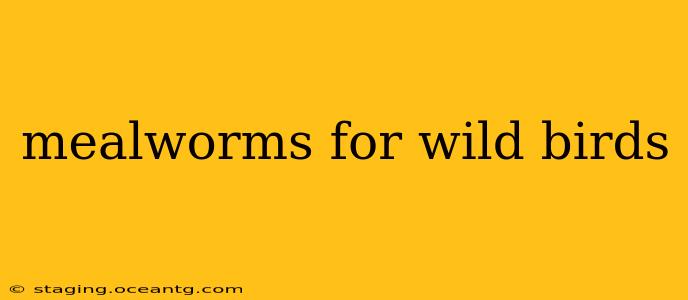Feeding wild birds is a rewarding hobby, connecting us with nature and supporting local avian populations. Mealworms, the larval form of the darkling beetle, are a popular supplementary food, offering a nutritious and readily accepted treat. However, understanding the benefits, drawbacks, and best practices for offering mealworms to wild birds is crucial for responsible bird feeding.
Are Mealworms Good for Wild Birds?
Mealworms are a good source of protein and fat, essential for energy and growth, particularly for fledglings and during colder months. They provide a valuable boost to a bird's diet, supplementing natural food sources. However, they shouldn't replace a balanced diet of seeds, nuts, fruits, and insects. Over-reliance on mealworms can lead to nutritional imbalances.
What Kinds of Wild Birds Eat Mealworms?
A wide variety of wild birds will readily consume mealworms. This includes:
- Robins: These ground-feeding birds often appreciate a mealworm treat.
- Bluebirds: These cavity nesters benefit from the extra protein, especially during breeding season.
- Wrens: These insectivorous birds will readily take mealworms offered in feeders or on the ground.
- Starlings: Though considered invasive in some areas, starlings are attracted to mealworms.
- Chickadees and Titmice: These smaller birds will happily pick up mealworms from a feeder.
The list is far from exhaustive; many other insectivorous and omnivorous bird species will happily eat mealworms.
How Often Should I Feed Wild Birds Mealworms?
Mealworms should be offered as a supplemental food, not the primary food source. Overfeeding can lead to obesity and nutritional deficiencies. A few mealworms several times a week is generally sufficient. Observe the birds' behavior – if they consistently ignore the mealworms, reduce the frequency or quantity.
Where Can I Buy Mealworms for Wild Birds?
Mealworms are readily available at pet stores, garden centers, and online retailers. Choose reputable suppliers to ensure the mealworms are healthy and free from pesticides. Live mealworms require refrigeration to maintain their freshness.
Can I Feed Wild Birds Dried Mealworms?
Dried mealworms are a convenient alternative to live mealworms, offering a longer shelf life. However, they lack the moisture content of live mealworms and may not be as appealing to some birds. A mixture of live and dried mealworms can provide a good compromise.
Are Mealworms Safe for Wild Birds?
When sourced from reputable suppliers, mealworms are generally safe for wild birds. However, ensure mealworms are free from pesticides or other harmful chemicals. Avoid offering mealworms that have been treated with preservatives or artificial colors.
What are the Benefits of Feeding Wild Birds Mealworms?
- Supplementary Nutrition: Mealworms provide essential protein and fats, beneficial for growth and energy.
- Attracting Diverse Species: Mealworms attract a wider variety of bird species to your yard.
- Supporting Breeding: The extra protein aids birds during the breeding season and helps raise healthy young.
- Winter Food Source: Mealworms can provide a crucial food source during harsh winter months when natural food sources are scarce.
What are the Potential Drawbacks of Feeding Wild Birds Mealworms?
- Nutritional Imbalance: Over-reliance on mealworms can lead to nutritional deficiencies.
- Attracting Undesirable Animals: Mealworms can also attract rodents and other animals.
- Dependence: Birds may become overly reliant on provided food, potentially hindering their natural foraging abilities.
- Mess: Mealworms can create mess if not offered in appropriate feeders.
By understanding the benefits and drawbacks, and following responsible feeding practices, you can offer mealworms to wild birds as a valuable, supplementary treat, enriching your backyard wildlife experience. Remember to always prioritize a balanced and varied diet for your feathered friends.
